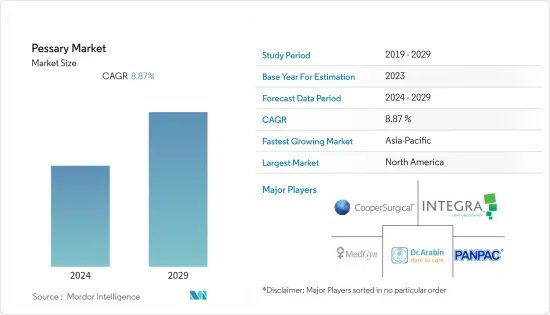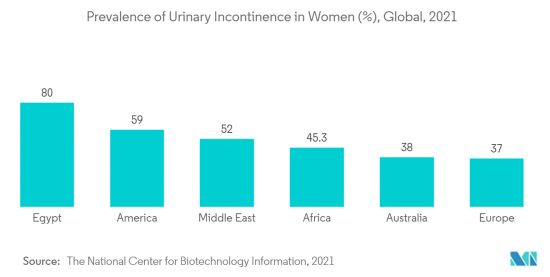
|
市場調査レポート
商品コード
1407069
ペッサリー:市場シェア分析、産業動向・統計、2024~2029年成長予測Pessary - Market Share Analysis, Industry Trends & Statistics, Growth Forecasts 2024 - 2029 |
||||||
カスタマイズ可能
適宜更新あり
|
|||||||
| ペッサリー:市場シェア分析、産業動向・統計、2024~2029年成長予測 |
|
出版日: 2024年01月04日
発行: Mordor Intelligence
ページ情報: 英文 113 Pages
納期: 2~3営業日
|
全表示
- 概要
- 目次
ペッサリー市場は予測期間中にCAGR 8.87%で成長すると予測されます。

COVID-19パンデミックは、製造工程の大幅な低下、需要と供給の制限、感染者との接触を避けるための通院制限などにより、ペッサリー市場の成長に大きな影響を与えています。交通手段の制限やウイルス感染の恐れから、国民のほとんどが補綴手術を延期しており、業界は悪影響を目の当たりにしています。このため、ペッサリーの膣挿入を含む手術も延期されました。しかし、サービスや補綴手術が再開されたことで、さまざまな骨盤底部障害の治療用ペッサリーの需要が増加しています。
骨盤臓器脱の有病率の増加、患者の尿失禁、非侵襲的治療オプションの採用増加、女性のライフスタイルの変化、老人人口の増加などの要因がペッサリー市場の成長を後押ししています。
尿失禁(UI)の有病率は女性や高齢者で高く、QOL(生活の質)に悪影響を及ぼすことが、市場の成長を促す主な要因となっています。尿失禁は、膀胱容量や満腹感の減少、起立筋収縮率の低下、骨盤底筋抵抗の低下、残尿量の増加など、下部泌尿器系の加齢に伴う変化により、人々の間で一般的になりつつあります。例えば、米国国立医学図書館(NLM)に掲載された論文によると、2022年8月には、世界中で推定4億2,300万人が何らかの形でUIを経験しています。同様に、2022年10月にScientific Reportsに掲載された論文によると、UIのリスクは初産年齢が32歳を超えると増加し、32歳より前に初産を迎えると減少することが観察されています。また、同出典によると、UIの有病率は妊娠中および産後期間中5%から70%です。従って、UI有病率の高さはペッサリーの需要を増加させ、市場の成長を増大させる。
さらに、女性の骨盤臓器脱の増加もペッサリー市場の成長に寄与しています。骨盤臓器脱の罹患率は、加齢や多胎妊娠後に増加します。2022年6月にScientific Reports誌に掲載された論文によると、UI、骨盤臓器脱(POP)、腸機能障害(排便困難や肛門失禁(AI))を含む骨盤底障害(PFD)は、プライマリケアの現場で受診する成人女性の間で一般的です。アイオワ州では、腸機能障害が女性のPFDで最も多く、全症例の24.6%を占め、尿失禁(11.1%)、骨盤臓器脱(POP)(4.4%)がこれに続くことが観察されています。さらに、同出典によると、約1.1%が3つのカテゴリーすべてに該当し、5.5%が2つのカテゴリーに該当していました。このように、女性における骨盤臓器脱の有病率の高さは、女性の骨盤臓器脱の問題を治療するためのペッサリーの需要を増加させ、市場の成長に寄与しています。
したがって、尿失禁や骨盤臓器脱の高い負担などの前述の要因により、調査対象市場は予測期間中に成長すると予想されます。しかし、患者の不快感や副作用への不安は、市場の成長を阻害する要因となっています。
ペッサリー市場の動向
リング型ペッサリーは予測期間中に大幅なCAGRで推移する見込み
リング型ペッサリー市場は、使いやすさや患者の快適さといった要因や、骨盤臓器脱や尿失禁の全段階、感染症予防に適していることから、予測期間中に大きな成長が見込まれます。リングペッサリーは経膣的に留置する器具で、尿道と膀胱頸部を安定させて支え、尿道を長くし、腹圧上昇時に恥骨に対して尿道を適度に圧迫します。ストレス性尿失禁の女性への使用に加え、コンチネンスリングペッサリーは、骨盤臓器脱の圧迫により尿意切迫感や頻尿を経験する特定の女性を助けることができます。
尿失禁と骨盤臓器脱の有病率の高さが、ペッサリーの需要を高めています。例えば、2021年11月にInternational Urogynaecology Journalに掲載された論文によると、約40%の女性が骨盤底機能障害や骨盤臓器脱(POP)を経験しており、ペッサリー治療は患者満足度(75.3%)、有効性(90.7%)が高く、膣や性的症状、生活の質、精神的健康の改善に良い影響を与える治療法の一つであることが確認されています。さらに、同じ情報源によると、膜のないリング型ペッサリーは、閉塞型(ゲルホーン型)や膜のある器具よりも膣分泌物が少なく、性行為を可能にする最も頻繁に使用されるタイプです。このため、ユーザー間での採用が増加し、このセグメントの成長を後押ししています。
さらに、骨盤臓器脱を治療するためのペッサリーの承認が高まっていることも、市場の成長に寄与するとみられます。例えば、WHOは2021年1月にダピビリン膣リング(DPV-VR)を推奨しており、併用予防アプローチの一環として、HIV感染リスクが高い女性に追加の予防選択肢を提供する可能性があります。また、食品医薬品局(FDA)は、女性の骨盤臓器脱の一時的な非外科的管理のための使い捨てアプリケータ付き膣リングペッサリーであるProVate(ConTIPI)を承認しました。
したがって、前述の要因から、このセグメントは予測期間中に大きく成長すると予想されます。

予測期間中、北米が大きな市場シェアを占める見込み
北米は、女性の高齢化、ホルモンの乱れを引き起こすライフスタイルの変化、骨盤臓器脱や尿失禁の有病率の上昇、健康意識の高まり、大手企業の存在などの要因により、大きな市場シェアを占めると予測されます。
尿失禁と骨盤臓器脱の有病率の増加は、この地域におけるペッサリー市場の成長を促す主な要因です。例えば、米国国立生物工学情報センター(NCBI)が発表した論文によると、2022年10月、年齢が進むことにより、20~39歳の女性の約9.7%、80歳以上の女性の49.7%が、生涯のうちに骨盤臓器脱を経験する可能性があります。同出典によれば、2050年までに骨盤臓器脱の患者数は59%増加すると予想されています。同様に、2021年8月にNCBIに掲載された論文によると、尿失禁は男性よりも女性に不釣り合いに多く影響し、60歳以上の女性で顕著に増加することが観察されています。
さらに、米国では高齢化、過体重、肥満が進んでおり、PFDが社会やヘルスケアシステムに与える負担や出費が増加すると予想されています。例えば、Scientific Reports誌に掲載された論文によると、2022年6月、米国では成人の約2人に1人が肥満になり、2030年には成人の約4人に1人が重度の肥満になると予測されています。このように、肥満人口の増加は、子宮膣脱だけでなく、さまざまな排尿、排便、性機能障害問題を発症するリスクを高めるため、予測期間中にペッサリーの需要を促進します。
さらに、骨盤底疾患の治療や非侵襲的な医療機器の開発に注力する市場プレイヤーの増加も、市場の成長に寄与しています。例えば、2021年6月、Femtherapeutics Inc.は、骨盤臓器脱の女性の尿失禁や不快感を和らげるために、人工知能主導の機械学習と3Dデザインを組み合わせた装置であるカスタムメイドペッサリーを開発していました。
このように、骨盤底障害の罹患率の増加、女性の高齢化人口の増加、治療のための非侵襲的医療機器の開発に注力するプレイヤーの台頭は、予測期間中の同地域の市場成長を促進すると予想されます。
ペッサリー産業の概要
ペッサリー市場は、国内外に多数のプレーヤーが存在し、競争が激しいです。新製品開拓、合併、買収、提携、協力は、市場プレーヤーがその地位を維持するために行う主要な戦略的活動の一部です。主なプレーヤーとしては、CooperSurgical Inc.、MedGyn Products Inc.、Panpac Medical Corporation、Integra Lifesciences、Dr. Arabin GmbH &Co.KGです。
その他の特典
- エクセル形式の市場予測(ME)シート
- 3ヶ月間のアナリスト・サポート
目次
第1章 イントロダクション
- 調査の前提条件と市場定義
- 調査範囲
第2章 調査手法
第3章 エグゼクティブサマリー
第4章 市場力学
- 市場概要
- 市場促進要因
- 骨盤臓器脱、尿失禁の有病率の増加、高齢者人口の増加
- 非侵襲的治療法の採用増加
- 女性の健康に対する関心の高まりと政府の取り組み
- 市場抑制要因
- 患者の不快感と副作用への恐怖
- ポーターのファイブフォース分析
- 新規参入業者の脅威
- 買い手/消費者の交渉力
- 供給企業の交渉力
- 代替品の脅威
- 競争企業間の敵対関係の強さ
第5章 市場セグメンテーション(市場規模)
- タイプ別
- ゲルホーン
- リング
- ドーナツ
- その他
- エンドユーザー別
- 病院薬局
- 小売薬局
- オンライン薬局
- 地域別
- 北米
- 米国
- カナダ
- メキシコ
- 欧州
- ドイツ
- 英国
- フランス
- イタリア
- スペイン
- その他の欧州
- アジア太平洋
- 中国
- 日本
- インド
- オーストラリア
- 韓国
- その他のアジア太平洋地域
- 中東・アフリカ
- GCC
- 南アフリカ
- その他の中東とアフリカ
- 南米
- ブラジル
- アルゼンチン
- その他南米
- 北米
第6章 競合情勢
- 企業プロファイル
- CooperSurgical Inc.
- Artisan Medical
- MedGyn
- Panpac Medical Corporation
- Bioteque America
- Personal Medical Corporation
- Dr. Arabin GmbH & Co. KG
- Integra Lifesciences
- Bray Group Limited
- Thomas Medical
- Bliss GVS Pharma Limited
第7章 市場機会と今後の動向

The pessary market is projected to grow with a CAGR of 8.87% during the forecast period.
The COVID-19 pandemic has had a substantial impact on the growth of the pessary market owing to the significant decline in manufacturing processes, restricted demand and supply, and restricted hospital visits to avoid contact with infectious people. The industry has witnessed a negative impact as most of the population defer prosthetic surgeries due to transportation restrictions and the fear of viral infection. This has also resulted in the postponement of procedures, which included vaginal insertion of pessary as well. However, with the resumed services and prosthetic procedures, the demand for pessaries for treating various pelvic floor disorders has increased, thus the studied market has witnessed significant growth and is expected to grow over the forecast period.
Factors such as the increasing prevalence of pelvic organ prolapse, urinary incontinence in patients, increasing adoption of non-invasive treatment options, changing women's lifestyles, and a rise in the geriatric population are boosting the growth of the pessary market.
The prevalence of urinary incontinence (UI) is higher in women and elderly patients and creates a negative impact on their quality of life, which is the key factor driving the growth of the market. Urinary incontinence is becoming more common among people due to aging-related changes in the lower urinary system, including decreased bladder capacity and fullness sensation, decreased detrusor muscle contraction rate, decreased pelvic floor muscle resistance, and increased residual urine volume. For instance, according to an article published in the National Library of Medicine (NLM), in August 2022, an estimated 423 million people experience some form of UI worldwide. Similarly, according to an article published in Scientific Reports, in October 2022, it has been observed that the risk of UI increases with the first birth age, greater than 32, and decreases if the first birth occurs before age 32. Also, as per the same source, the prevalence of UI ranges between 5% to 70% during pregnancy and the postnatal period. Thus, the high prevalence of UI increases the demand for pessaries, thereby increasing the market's growth.
In addition, the increasing incidences of pelvic organ prolapse in females contribute to the pessary market's growth. The incidences of pelvic organ prolapse increase with age and after multiple pregnancies. According to an article published in Scientific Reports, in June 2022, pelvic floor disorders (PFD) which include UI, pelvic organ prolapse (POP), and bowel dysfunction (difficult defecation and anal incontinence (AI)) are common among adult women seeing in primary care settings. It has been observed that bowel dysfunction was the most prevalent PFD among women, accounting for 24.6% of all cases, followed by urine incontinence (11.1%) and pelvic organ prolapse (POP) (4.4%) in Iowa. Additionally, as per the same source, about 1.1% had all three categories of PFD, and 5.5% had precisely two PFD. Thus, the high prevalence of pelvic organ prolapse in women increases the demand for pessaries to treat pelvic organ prolapse issues in women, thereby contributing to the market growth.
Therefore, owing to the aforementioned factors, such as the high burden of urinary incontinence and pelvic organ prolapse, the studied market is anticipated to grow over the forecast period. However, patient discomfort and fear of side effects are some factors that hinder the market's growth.
Pessary Market Trends
Ring Pessary Segment Expects to Register a Significant CAGR Over the Forecast Period
The ring pessary segment is expected to witness significant growth over the forecast period owing to the factors such as ease of usage and patient comfort and is appropriate for all stages of pelvic organ prolapse and urinary incontinence as well as for the prevention of infectious diseases. Ring pessaries are transvaginally implanted devices that stabilize and support the urethra and bladder neck, lengthen the urethra, and provide moderate compression of the urethra against the pubic bone during a rise in intra-abdominal pressure. In addition to its use in women with stress urinary incontinence, a continence ring pessary may help certain women who experience urine urgency and frequency due to pelvic organ prolapse pressure.
The high prevalence of urinary incontinence and pelvic organ prolapse increases the demand for pessaries. For instance, according to an article published in the International Urogynaecology Journal, in November 2021, it has been observed that about 40% of women experience pelvic floor dysfunction or pelvic organ prolapse (POP), and pessary treatment is one therapy option that has a high level of patient satisfaction (75.3%), efficacy (90.7%) and a positive impact on the improvement of vaginal and sexual symptoms, quality of life, and mental health. In addition, as per the same source, the ring pessary without a membrane is the most frequently used type that allows for sexual activity while retaining less vaginal discharge than occlusive (Gellhorn) varieties or devices with a membrane. This increases their adoption among the users hence propelling the segment's growth.
Moreover, the rising approvals for pessaries to treat pelvic organ prolapse are likely to contribute to the market growth. For instance, in January 2021, WHO recommended a dapivirine vaginal ring (DPV-VR) that may offer an additional prevention choice for women at substantial risk of HIV infection as part of combination prevention approaches. Also, the Food and Drug Administration (FDA) has approved ProVate (ConTIPI), a vaginal ring pessary with a disposable applicator for the temporary, nonsurgical management of pelvic organ prolapse in women.
Hence, due to the aforementioned factors, the segment is anticipated to grow at a significant growth over the forecast period.

North America is Expected to Have the Significant Market Share Over the Forecast Period
North America is anticipated to have a significant market share owing to the factors such as the aging female population, lifestyle changes that cause hormonal disruptions, the rising prevalence of pelvic organ prolapse and urinary incontinence, increased health awareness, and the presence of major players.
The increasing prevalence of urinary incontinence and pelvic organ prolapse are the major factor driving the growth of the pessary market in the region. For instance, according to an article published by the National Center for Biotechnology Information (NCBI), in October 2022, due to advancing age, approximately 9.7% of women between the ages of 20 and 39 and 49.7% of women over the age of 80 are likely to experience pelvic organ prolapse during their lives. As per the same source, by 2050, the number of people with pelvic organ prolapse is expected to rise by 59%. Similarly, according to an article published in the NCBI, in August 2021, it has been observed that urinary incontinence affects women disproportionately more than males and it significantly increases among women aged 60 years and older.
Additionally, the aging, overweight, and obese population of the United States is expected to add to the burden and expense of PFD on society and the healthcare system. For instance, according to an article published in Scientific Reports, in June 2022, about 1 in 2 adults is expected to be obese, and nearly 1 in 4 adults are projected to have severe obesity by 2030 in the United States. Thus, the increase in the obese population increases the risk of developing a range of urinary, bowel, and sexual dysfunction problems as well as uterovaginal prolapse, hence propelling the demand for pessaries over the forecast period.
Moreover, the increasing focus of the market players on developing treatment and non-invasive medical devices for treating pelvic floor diseases is also contributing to the market's growth. For instance, in June 2021, Femtherapeutics Inc. was developing a custom-made pessary, a device that combined artificial intelligence-driven machine learning and 3D design to relieve urine incontinence and discomfort in women with pelvic organ prolapse.
Thus, the increasing incidences of pelvic floor disorders, the increasing number of women's aging population, and the rising focus of players to develop non-invasive medical devices for treatment are expected to propel the market's growth in the region over the forecast period.
Pessary Industry Overview
The pessary market is highly competitive with a huge number of domestic as well as international players. New product development, mergers, acquisitions, partnerships, and collaboration are some of the primary strategic activities undertaken by market players to withhold their positions. Some of the key players are CooperSurgical Inc., MedGyn Products Inc., Panpac Medical Corporation, Integra Lifesciences, and Dr. Arabin GmbH & Co. KG.
Additional Benefits:
- The market estimate (ME) sheet in Excel format
- 3 months of analyst support
TABLE OF CONTENTS
1 INTRODUCTION
- 1.1 Study Assumptions and Market Definition
- 1.2 Scope of the Study
2 RESEARCH METHODOLOGY
3 EXECUTIVE SUMMARY
4 MARKET DYNAMICS
- 4.1 Market Overview
- 4.2 Market Drivers
- 4.2.1 Increasing Prevalence of Pelvic Organ Prolapse, Urinary Incontinence and Rise in Geriatric Population
- 4.2.2 Increasing Adoption of Non-Invasive Treatement Options
- 4.2.3 Rising Concern for Women's Health and Government Initiatives
- 4.3 Market Restraints
- 4.3.1 Patient Discomfort and Fear of Side Effects
- 4.4 Porter's Five Forces Analysis
- 4.4.1 Threat of New Entrants
- 4.4.2 Bargaining Power of Buyers/Consumers
- 4.4.3 Bargaining Power of Suppliers
- 4.4.4 Threat of Substitute Products
- 4.4.5 Intensity of Competitive Rivalry
5 MARKET SEGMENTATION (Market Size by Value - USD million)
- 5.1 By Type
- 5.1.1 Gellhorn
- 5.1.2 Ring
- 5.1.3 Donut
- 5.1.4 Others
- 5.2 By End User
- 5.2.1 Hospital Pharmacies
- 5.2.2 Retail Pharmacies
- 5.2.3 Online Pharmacies
- 5.3 Geography
- 5.3.1 North America
- 5.3.1.1 United States
- 5.3.1.2 Canada
- 5.3.1.3 Mexico
- 5.3.2 Europe
- 5.3.2.1 Germany
- 5.3.2.2 United Kingdom
- 5.3.2.3 France
- 5.3.2.4 Italy
- 5.3.2.5 Spain
- 5.3.2.6 Rest of Europe
- 5.3.3 Asia-Pacific
- 5.3.3.1 China
- 5.3.3.2 Japan
- 5.3.3.3 India
- 5.3.3.4 Australia
- 5.3.3.5 South Korea
- 5.3.3.6 Rest of Asia-Pacific
- 5.3.4 Middle East and Africa
- 5.3.4.1 GCC
- 5.3.4.2 South Africa
- 5.3.4.3 Rest of Middle East and Africa
- 5.3.5 South America
- 5.3.5.1 Brazil
- 5.3.5.2 Argentina
- 5.3.5.3 Rest of South America
- 5.3.1 North America
6 COMPETITIVE LANDSCAPE
- 6.1 Company Profiles
- 6.1.1 CooperSurgical Inc.
- 6.1.2 Artisan Medical
- 6.1.3 MedGyn
- 6.1.4 Panpac Medical Corporation
- 6.1.5 Bioteque America
- 6.1.6 Personal Medical Corporation
- 6.1.7 Dr. Arabin GmbH & Co. KG
- 6.1.8 Integra Lifesciences
- 6.1.9 Bray Group Limited
- 6.1.10 Thomas Medical
- 6.1.11 Bliss GVS Pharma Limited


